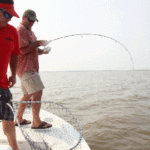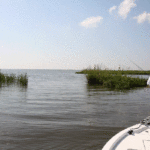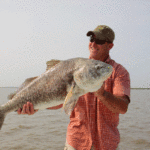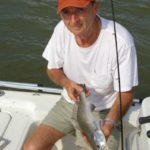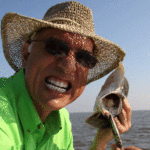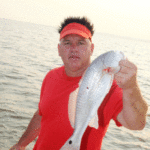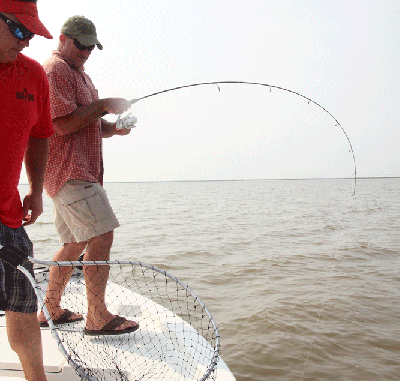
Head to Vermilion Bay’s Trash Pile to clean up on fish of all species.
Making a clean sweep seems to always make things feel a little fresher.
And sweeping up a mess of redfish, flounder, black drum and speckled trout at a spot near Weeks Bay called the “Trash Pile” is a good way to do a little housekeeping this summer.
Someone who knows a thing or two about housekeeping is Eddie Darce. Darce and his wife Cindy are co-owners of “Cuddin Eddie’s Pepper Relish Products,” where cleaning up following a long day of cooking is the norm.
An avid angler who fishes both salt and fresh water, Darce also knows how to clean up on fish.
Living in Patterson, Darce fishes the Atchafalaya Basin for chinquapins and goggle-eyes on one given Saturday and fish the Trash Pile, launching out of Cypremort Point, the next.
Darce and I decided to do a little housekeeping of our own at the Trash Pile recently. Heading northwest into Vermilion Bay, following the bread crumbs on his GPS out of the Quintana public boat landing, we rounded a point and made a sharp north-northeastly turn toward the Pile.
The sun looked like an orange ball, giving the sky a violet-colored hue as we set anchor for the morning cleanup.
Satisfied with dragging a Saltwater Assassin plastic fixed to a 1/4-ounce jighead tipped with a little piece of dead shrimp for odor enticement, we both started sweeping up the bottom.
First a bump, then a tap, followed by a brief pause, then sudden but solid pull told me I had better hang on.
My initial cleanup had me adjusting the drag.
Confident in the adjustment and hoping I’d made the right decision to string some fresh 10-pound-test Stren Microfuse line onto all of my rods for the occasion, I let the fish run at will.
From the way it fought, staying on the bottom and sort of bulling its way along, my guess was it had to be a black drum.
When the fish would stop briefly to rest, I’d use the pause to my advantage and make up some lost ground, reeling in the clump of living debris I’d swept up.
Local stories are vague on how the Trash Pile came about. Some of the old timers say the location is where oil-field service companies and commercial shrimpers would sometimes dump their refuse and discard old junk, thus giving it its name.
Whatever the case, the bottom is a mix of shells, pieces of rotted wood, the occasional abandoned crab trap and mud — all of which is attractive to a variety of fish, and no species seemingly in more supply than the other, except perhaps croakers.
The Trash Pile is filthy with croakers.
The tug of war ended with us releasing the drum for fear of it having grown so large that it would be full of unappetizing worms from a psychological standpoint.
We’d stick with puppy black drums and let their great uncles, bruisers that regularly weigh over 40-pounds, go to fight another day.
Big black drum are a species of Trash Pile fish you can actually target using a meat method. Anglers can take a 3/0 or larger Kahle hook and Carolina rig it with a 1-ounce bullet weight, and fish off the bottom using a half of crab for bait.
Tying the hook using a snell knot aligns the line with the hook’s shank for more reliable catches.
Another method for catching black drum is to use a three-way rig set up. Placing a 4-ounce weight at the bottom, with a 4/0 circle hook suspended above with a large chunk of crab, is deadly where drum are lurking.
This is strictly tight line fishing, where waiting it out is the norm. If you’re into numbers, this slow, leisurely drum fishing isn’t nearly as exciting as fishing plastics or using a popping cork.
But it is an effective way to target this particular species.
By contrast, while I was hooking drum, Darce had a methodical, slow process going to catch a flounder. It was a tactic he learned growing up in a family of fishermen who loved to bass fish in the basin.
“When speck fishing the Pile, I’ll use a jig — something like 1/4-ounce — so as not to get hung up on the bottom too often,” Darce said. “I’ll use Saltwater Assassin plastics using colors that resemble shrimp. But, for flounder you have to slowly reel and crawl the bait along the bottom.
“You’ll get a tap-tap-tap that feels like a perch hitting it. Don’t be too anxious to jerk the line like you would a bass. Let him take it — then set the hook.”
Darce’s method proved to be effective, allowing him to land a few flounder as big as pizza pans.
Lafayette resident Danny Womack has frequented Vermillion Bay in the past in search of speckled trout. But Womack said flounder hold a special place in his heart.
“That flounder is a real special fish,” he said. “That whole area from the Trash Pile to right along bank near Weeks Island is good for them, and really all the way towards Delcambre.
“I have a friend who lives on Weeks Island and fishes them regularly.”
Because flounder bite sideways, it’s hard to hook them consistently with standard tackle. Something anglers who target flounder can do to improve their catch is take a pair of pliers and turn the hooks on their jigheads 90-degrees, where the poits are perpendicular to the eye.
Betts tackle has come up with a better widget: their Billy Bay Flounder Fanatic hooks. These hooks are weedless, and can be used with both plastic lures and live bait.
Anglers also can do a little sweeping up on redfish, too, and not just on the Trash Pile. There are plenty of banks to troll and toss popping corks at in this area, with dead shrimp or plastics fixed to jigs.
Moreover, like all along the coast, moving water that rushes through little passes, drains from trenausses and ponds, and spills across any point are good locations to use this proven technique.
Effective plastics for redfish include H&H Cocahoe Minnows, Deadly Dudleys and Stanley Wedgetail Mullets. Colors should include avocado red glitter, chartreuse and chartreuse/black.
Anglers who prefer artificial baits for sweeping up a few redfish should also include Rat-L-Traps, XCalibur Rattle Baits and Johnson Silver Spoons in their repertoire.
A couple of the better colors for banging the banks are chrome blue and silver.
Speckled trout fishing around the Trash Pile can be hit or miss, and is influenced heavily by fresh water during the spring and early summer.
But, that doesn’t mean anglers can’t sweep up a few during the hotter months.
“For trout, all of that area gets better the later into the summer it gets,” Womack said. “There’s so much fresh water that loops around that way from the Atachafalaya River and Spillway, it’s not (good) until the river drops well below flood stage — where it allows salt water to come into Vermillion and Weeks Bays. And that usually is when the river in Morgan City is at 2 to 3 feet.
“But, one of the best days speck fishing that I ever had was right there on the Trash Pile.”
Anglers going to the Trash Pile for the first time shouldn’t be surprised at how many boats are anchored up. It’s normal throughout much of the summer — weekends especially.
During our recent outing we counted no less than 12 other boats anchored. However, the area is big enough to handle plenty of vessels.
The region is subject to weather, where rain and high winds often cause both Vermilion and Weeks bays to become dirty with an influx of freshwater, stifling the fishing for several days.
But, given enough time, things will settle back to normal and anglers can return to the Trash Pile to do a little housekeeping.
Just don’t forget to bring your best brooms.
